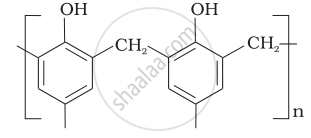Advertisements
Advertisements
Question
Write two uses and two properties of polythene.
Solution
Uses of high-density polyethylene:
- HDP is used in the manufacture of toys and other household articles like buckets, dustbins, bottles, pipes, etc.
- It is used to prepare laboratory wares and other objects where high tensile strength and stiffness is required.
Properties of high-density polyethylene:
- HDP is crystalline, melting point in the range of 144 - 150 °C.
- It is much stiffer than LDP and has high tensile strength and hardness.
- It is more resistant to chemicals than LDP.
APPEARS IN
RELATED QUESTIONS
Write any ‘two' uses of terylene.
Draw the structures of veronal and thymine.
Choose the correct option from the given alternatives.
Which of the following is made up of polyamides?
Answer the following in one sentence.
Identify 'B' in the following reaction:
\[\ce{H2N -(CH2)6 - NH2 + HOOC - (CH2)4 - COOH ->[N2][533 K]}\]'B'
Answer the following in one sentence.
What type of intermolecular force leads to high-density polymer?
Answer the following.
Write the reaction of the formation of Terylene.
Answer the following.
Name the polymer type in which following linkage is present.
\[\begin{array}{cc}\ce{- C - O -}\\||\phantom{.....}\\
\ce{O\phantom{.....}}\end{array}\]
Answer the following.
Match the following pairs:
| Name of polymer | Monomer |
| 1. Teflon | a. CH2 = CH2 |
| 2. PVC | b. CF2 = CF2 |
| 3. Polyester | c. CH2 = CHCl |
| 4. Polythene | d. C6H5OH and HCHO |
| 5. Bakelite | e. Dicarboxylic acid and polyhydoxyglycol |
Answer the following.
Draw the structures of polymers formed from the following monomers
H2N–(CH2)5 – COOH
Identify condensation polymers and addition polymers from the following.
\[\begin{array}{cc}\ce{-(CH2 - CH -)_{n}}\\
\phantom{....}|\\\ce{\phantom{.......}C6H5}
\end{array}\]
Identify condensation polymers and addition polymers from the following.
-(CO(CH2)4 - CONH(CH2)6NH-)n
Attempt the following:
Write preparation, properties and uses of Teflon.
Write chemical reaction for preparation of the following.
Neoprene
Explain vulcanization of rubber.
Define rubber.
The following structure represents the polymer:
\[\begin{array}{cc}
\ce{[-C-CH2-NH-C-(-CH2)5 NH -]_{{n}}}\\
\phantom{}||\phantom{.............}||\phantom{................}\\
\phantom{}\ce{O}\phantom{.............}\ce{O}\phantom{................}
\end{array}\]
Which among the following polymers is used for making handles of cooker?
Which of the following polymer is used in paints?
The INCORRECT match for the polymer with its application is:
Identify the INCORRECT match.
Which of the following polymers is obtained from chloroprene?
Novolac is obtained from ____________.
Which among the following polymers is obtained from CH2 = CH – CN by polymerisation?
Which among the following catalysts is used in the preparation of dacron?
Identify the monomers used in the preparation of Novolac.
Identify the catalyst used in the manufacture of high density polythene.
Which of the following pair of compounds is used as monomers for bakelite?
Which of the following polymer is used to make blankets?
Identify addition polymer from the following.
Match the polymers given in Column I with the type of linkage present in them given in Column II.
| Column I | Column II |
| (i) Terylene | (a) Glycosidic linkage |
| (ii) Nylon | (b) Ester linkage |
| (iii) Cellulose | (c) Phosphodiester linkage |
| (iv) Protein | (d) Amide linkage |
| v) RNA |
Match the polymers given in Column I with their repeating units given in Column II.
| Column I | Column II |
| (i) Acrilan |
(a) \[\begin{array}{cc} |
| (ii) Polystyrene | (b) \[\begin{array}{cc} \ce{Cl}\phantom{.......}\\ |\phantom{........}\\ \phantom{}\ce{-(CH2 - C = CH - CH2)\underset{n}{-}} \end{array}\] |
| (iii) Neoprene | (c) \[\begin{array}{cc} \phantom{................................}\ce{CN}\\ \phantom{..............................}|\\ \ce{-(CH2 - CH = CH - CH2 - CH2 - CH)\underset{n}{-}} \end{array}\] |
| (iv) Novolac | (d) \[\begin{array}{cc} \ce{-(CH2 - CH)\underset{n}{-}}\\ \phantom{.....}|\\ \phantom{.......}\ce{CN} \end{array}\] |
| (v) Buna—N | (e)  |
| (f) \[\begin{array}{cc} \ce{-(CH2 - CH)\underset{n}{-}}\\ \phantom{.....}|\\ \phantom{......}\ce{Cl} \end{array}\] |
Phenol and formaldehyde undergo condensation to give a polymar (A) which on heating with formaldehyde gives a thermosetting polymer (B). Name the polymers. Write the reactions involved in the formation of (A). What is the structural difference between two polymers?
The monomer of Teflon is ______.
Which of the following polymer has ester linkage?
Polymer used in bullet proof glass is ______.
Which of the following polymers do not involve cross linkages?
Which of the following polymer is used for manufacturing of buckets, dustbins, pipes, etc?
Which of the following is a polymer of enzyme?
Which of the foolowing polymer is used in the manufacture of insulators.
Answer the following.
Write the structure of isoprene and the polymer obtained from it.
Answer the following.
Write the structure of isoprene and the polymer obtained from it.
Name and draw the structure of the repeating unit in natural rubber.
Name the compound which reacts with formaldehyde to produce ethyl alcohol.
Write the structure and name of monomer of Nylon-6.
Write the structure of isoprene and the polymer obtained from it.
Write the structure of isoprene and the polymer obtained from it.
Name and draw structure of the repeating unit in natural rubber.
Write the structure of isoprene and the polymer obtained from it.
Name and draw structure of the repeating unit in natural rubber.
Write the structure of isoprene and the polymer obtained from it.
Name and draw structure of the repeating unit in natural rubber.
Write the structure of isoprene and the polymer obtained from it.
Write the structure of isoprene and the polymer obtained from it.
